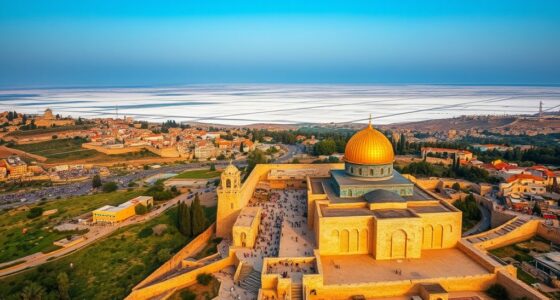Israel’s history is a tapestry of ancient origins, from the biblical kingdoms and the First Temple to periods of exile, foreign rule, and cultural resilience. Its modern identity forms through Zionist movements, the founding of the state in 1948, and ongoing conflicts and peace efforts. The country’s rich culture reflects diverse religious sites like Jerusalem’s sacred landmarks and the blending of Jewish, Christian, and Islamic traditions. Exploring more reveals how this vibrant history shapes Israel’s unique national character today.
Key Takeaways
- Israel’s history spans from ancient Israelite kingdoms and biblical heritage to modern statehood, shaped by exile, revival, and conflicts.
- Jerusalem holds profound religious significance for Judaism, Christianity, and Islam, with iconic sites like the Western Wall and Al-Aqsa Mosque.
- The Jewish cultural identity has evolved through diaspora, Hellenistic influence, and the Zionist movement leading to the establishment of Israel.
- Israel’s society is a diverse mosaic of Jewish, Arab, and minority cultures, reflected in its languages, traditions, and festivals.
- Key historical events include the building of the First and Second Temples, Babylonian exile, Hellenistic influence, Ottoman rule, and modern peace efforts.
Ancient Foundations and Biblical Heritage

Steeped in history and sacred tradition, the ancient foundations of Israel are rooted in biblical narratives that have shaped Jewish identity for millennia. You learn that around 1446 BC, the Israelites’ Exodus from Egypt marks a pivotal moment, symbolizing liberation and divine promise. By approximately 1406 BC, you see the Israelites entering the Promised Land, establishing their early territorial roots. The reigns of kings like Saul and David around 1043–970 BC solidify Jerusalem as the spiritual and political center. Solomon’s temple, completed circa 970 BC, becomes a symbol of faith and unity. These stories forge a deep connection to the land, emphasizing divine covenant, leadership, and enduring cultural identity that continues to influence Jewish life and thought today.
The Formation of the Kingdoms and Early Monarchy
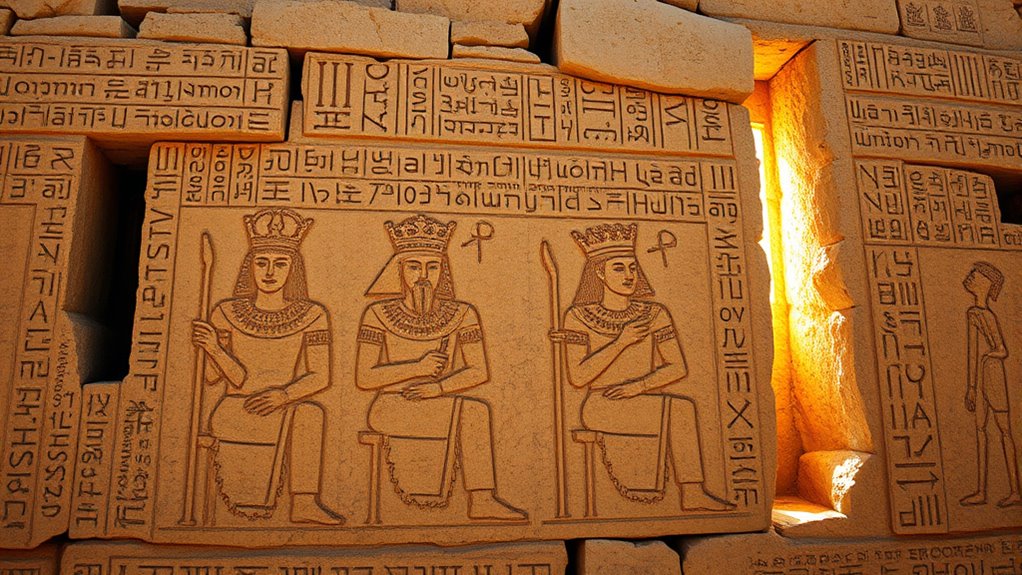
The formation of the Israelite kingdoms marked a significant shift from tribal confederations to centralized political entities. You witness this changeover as the tribes unite under a monarchy, beginning with Saul around 1043 BC. His reign sets the stage for stronger leadership, but it’s David who truly consolidates power, making Jerusalem the capital and establishing a unified nation around 1010 BC. David’s son, Solomon, continues this legacy, building the First Temple and fostering a period of prosperity. After Solomon’s death, the kingdom splits into Israel in the north and Judah in the south around 931 BC. This division leads to internal struggles and external threats, culminating in the Assyrian conquest of Israel and the Babylonian exile of Judah. These events mark critical turning points in Israel’s early political history. Additionally, the development of a centralized government was supported by the establishment of monarchical institutions, which helped organize and legitimize the new political structure.
The Exile, Return, and the Second Temple Period

After the Babylonian conquest in 586 BC, many Jews were forced into exile, dispersing across Persia and beyond. During this period, you experience the loss of the First Temple and the dislocation of your community. Despite this, hope remains, and some return to Jerusalem when Persia conquers Babylon in 539 BC. Under Persian rule, you rebuild the Temple, completing the Second Temple in 515 BC, renewing your spiritual center. Leaders like Ezra and Nehemiah lead reforms, strengthening your religious and cultural identity. Over time, Greek influence begins after Alexander the Great’s conquest in 332 BC. This era sees your community adapting, maintaining your traditions amidst foreign rule, setting the stage for further cultural developments and conflicts that shape your history. Applying skincare patches during this period of cultural change can be likened to maintaining resilience and adaptability in your traditions.
Hellenistic Influence and Jewish Political Independence

When Alexander the Great’s conquest reaches Israel, Hellenistic culture begins to influence local traditions and politics. This period sparks the Hasmonean Revolt, a pivotal event that restores Jewish political independence for a time. Understanding these shifts helps you see how cultural exchange and resistance shaped Israel’s history. Additionally, the integration of precious metals investment principles during this era reflects the enduring value placed on sovereignty and economic independence.
Hellenistic Cultural Impact
Hellenistic influence profoundly transformed Jewish culture and politics after Alexander the Great’s conquest of the Land of Israel in 332 BC. You see, Greek language, art, and ideas spread rapidly, blending with local traditions. This cultural infusion led to:
- The adoption of Greek language and literature among many Jews.
- The emergence of Hellenistic philosophies shaping Jewish thought.
- The construction of Greek-style cities and temples alongside Jewish sites.
- The spread of Hellenistic customs, clothing, and education.
- The dissemination of Hellenistic art that influenced Jewish artistic expression.
Despite these influences, Jewish communities sought to maintain their religious identity and independence. The clash between Hellenistic culture and Jewish traditions sparked tensions, eventually resulting in the Maccabean revolt. This revolt led to a brief period of political independence, highlighting the resilience of Jewish identity amidst Hellenistic dominance.
Hasmonean Revolt Significance
The spread of Hellenistic culture into the Land of Israel challenged Jewish traditions and sparked widespread unrest. In response, the Hasmonean Revolt (166–160 BC) erupted as a bold movement for religious and political independence. Led by the Maccabees, you fought against Seleucid rulers who imposed Hellenistic practices and suppressed Jewish worship. Your victory restored Jewish sovereignty temporarily and led to the establishment of the Hasmonean Kingdom, which asserted Jewish independence and religious autonomy. This revolt was a turning point, reaffirming your cultural identity and resistance against foreign influence. It also inspired future generations to preserve Jewish traditions amid foreign rule, shaping your national consciousness and religious resilience. Ultimately, the revolt symbolized your determination to maintain your religious and political independence in the face of Hellenistic dominance. Embracing cultural identity and resilience became central themes in your history.
Ottoman Rule and the Rise of Zionism
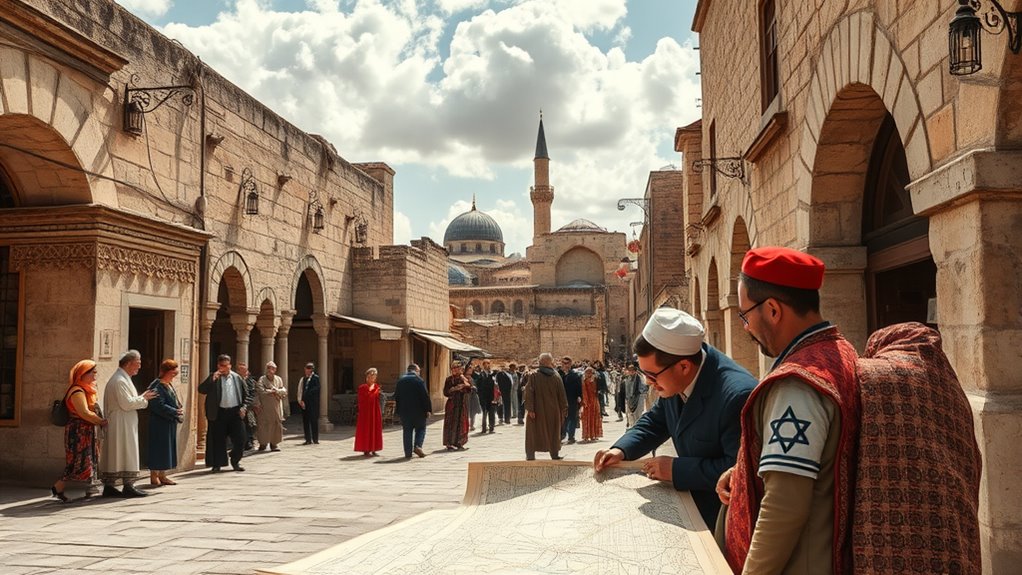
Have you ever wondered how Ottoman rule shaped the future of Zionism? During this period, the region was part of the vast Ottoman Empire, which controlled Palestine from 1517 to 1917. Under Ottoman rule, Jewish communities experienced relative stability but remained a minority amid Arab-majority populations. The late 19th century saw the emergence of Zionism, driven by European anti-Semitism and a desire for Jewish self-determination. Key aspects include:
- Jewish immigration increased, especially during the First Aliyah (1881–1903).
- The Ottoman government initially supported Jewish settlement but later imposed restrictions.
- Zionist leaders promoted land purchase and cultural revival to establish a Jewish homeland.
- The decline of Ottoman authority in World War I created opportunities for political change.
This period laid the groundwork for the eventual establishment of a Jewish state.
The Birth of the Modern State of Israel

Ever wondered how Israel officially transformed from a political movement into an independent nation? In 1948, David Ben-Gurion declared independence, ending British rule. The next day, neighboring Arab countries invaded, sparking the War of Independence. Despite challenges, Israel secured its borders through armistice agreements in 1949. The Law of Return in 1950 welcomed Jewish immigrants worldwide, shaping its demographics. You see, this period marked Israel’s *conversion* from Zionist aspirations to a sovereign state amid ongoing conflicts and diplomatic efforts. The table below summarizes these key ideas:
| Event | Impact |
|---|---|
| Declaration of Independence | Established Israel as a nation |
| Arab invasion | Led to the War of Independence |
| Armistice agreements | Defined borders and peace foundation |
You might also find it interesting how international recognition played a vital role in solidifying Israel’s sovereignty during this transformative period.
Key Conflicts and Peace Efforts in Contemporary Israel
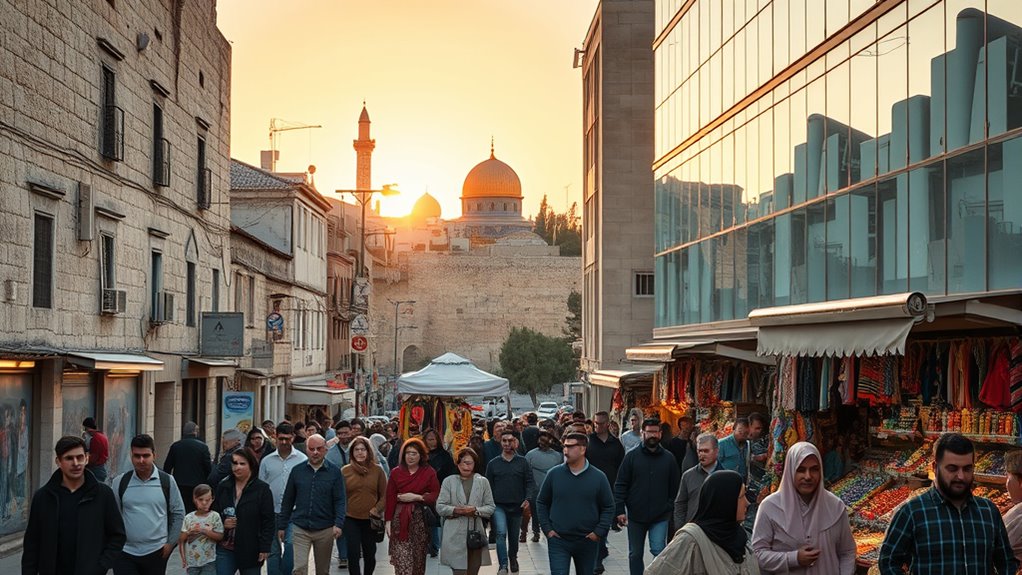
You see that Israel has faced ongoing conflicts, from wars with neighboring states to Palestinian uprisings, shaping its modern history. Despite these struggles, numerous peace negotiations, like the Oslo Accords, aim to find lasting solutions. Examining these conflicts and efforts reveals the complex journey toward stability in the region. Additionally, understanding music therapy can offer insights into how cultural and emotional healing processes are integral to societal resilience.
Major Conflicts Overview
What are the key conflicts and peace efforts that have shaped modern Israel’s history? You’ve seen ongoing struggles with neighboring Arab states, including wars in 1948, 1956, 1967, and 1973. The Arab-Israeli conflict has also involved territorial disputes, especially over Jerusalem and Palestinian territories. Major peace efforts include Egypt’s 1978 peace treaty and various negotiations like the Oslo Accords. To envision this, consider:
- The 1948 War of Independence, leading to borders and refugee issues
- The Six-Day War in 1967, capturing East Jerusalem and Gaza
- The Yom Kippur War in 1973, challenging Israel’s security
- Peace treaties with Egypt and Jordan, establishing diplomatic ties
These conflicts and efforts continue to influence Israel’s regional relationships and internal security landscape. Vetted – Nightingale Studio
Peace Negotiation Efforts
Peace negotiation efforts in modern Israel have played a pivotal role in shaping the country’s regional relationships and internal stability. You’ve seen multiple attempts to resolve long-standing conflicts, from the Oslo Accords in the 1990s to the Camp David Summit in 2000. These efforts aim to establish a two-state solution, addressing Palestinian aspirations and Israeli security concerns. You’ll notice that negotiations often face setbacks, influenced by political shifts, violence, and mutual distrust. Despite these challenges, diplomatic initiatives persist, with international mediators pushing for treaties and confidence-building measures. Israel continues to engage in peace talks, understanding that lasting peace requires compromise, patience, and persistent diplomacy. Your awareness of these ongoing efforts highlights their importance in shaping Israel’s future stability and regional relations. Additionally, the role of international mediators remains crucial in facilitating dialogue and fostering trust between the parties involved.
Religious Significance and Sacred Sites

Jerusalem stands as the heart of Israel’s religious significance, embodying sacred sites central to Judaism, Christianity, and Islam. You can feel its spiritual weight through landmarks like the Western Wall, where Jewish prayers have echoed for centuries; the Church of the Holy Sepulchre, believed to be Jesus’ burial site; the Al-Aqsa Mosque, a key Islamic sanctuary; and Mount Moriah, home to the Dome of the Rock. These sites attract millions who seek connection, reflection, or pilgrimage. Together, they represent a tapestry of faiths deeply rooted in history. Jerusalem’s sacred spaces shape the spiritual identity of millions and continue to influence religious practices, cultural traditions, and the enduring quest for peace among diverse communities. Incorporating iterative processes into religious and cultural preservation efforts can help ensure these sacred sites remain meaningful for future generations.
Cultural Diversity and National Identity
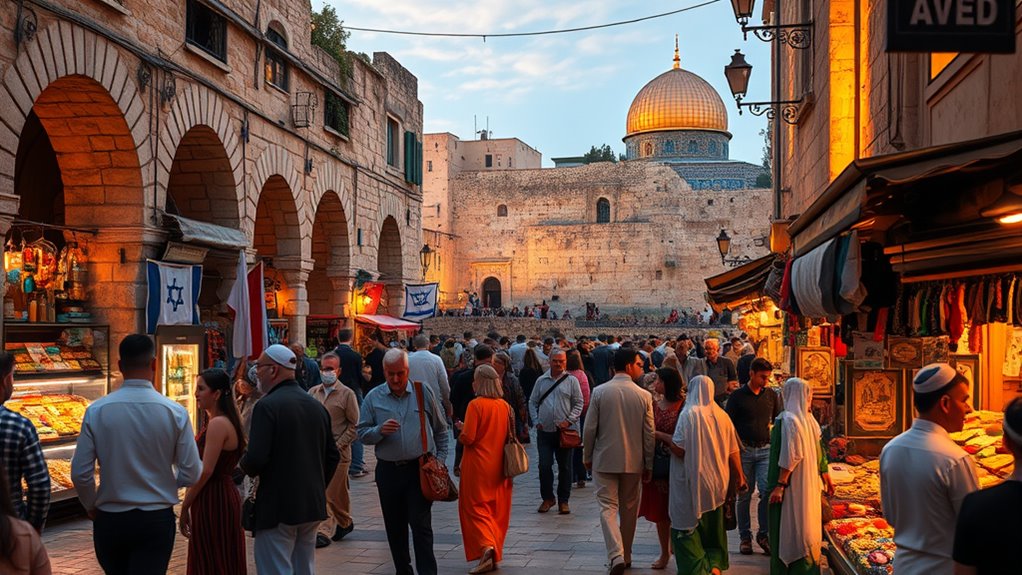
The sacred sites and religious traditions of Jerusalem have helped shape Israel’s deep-rooted spiritual identity, but the country’s cultural landscape extends far beyond faith alone. You experience a vibrant mosaic of traditions, languages, and histories that define Israel’s national identity. Jewish immigrants from different diasporas bring unique customs, while Arab minorities maintain their own cultural practices. This diversity fosters a dynamic society where multiple identities coexist and influence each other. Understanding this complexity helps you see Israel as more than just a land of sacred sites — it’s a place where history, culture, and modernity intertwine. Here’s a deeper insight:
| Culture Aspect | Influence | Significance |
|---|---|---|
| Language | Hebrew, Arabic | Symbols of identity |
| Cuisine | Mediterranean, Middle Eastern | Cultural expression |
| Festivals | Jewish, Muslim, Christian | Celebrating diversity |
| Art & Music | Traditional & modern | Cultural dialogue |
| Customs | Rituals & traditions | Heritage preservation |
Frequently Asked Questions
How Did Ancient Israelite Culture Influence Modern Israeli Society?
Your modern Israeli society is deeply influenced by ancient Israelite culture through shared religious traditions, language, and historical identity. You see this in the central role of Jerusalem, the Hebrew language revival, and the celebration of biblical holidays. These elements forge a connection to your ancestors, shaping national values, cultural practices, and a sense of continuity that links your everyday life to the ancient roots of Israelite civilization.
What Role Do Religious Traditions Play in Contemporary Israeli Life?
Religious traditions play a surprisingly central role in modern Israeli life, even if many claim to be secular. You’ll find that holidays, kosher laws, and religious sites like Jerusalem’s Old City influence daily routines and politics alike. Ironically, despite boasting a high-tech, modern society, you can’t escape the deep roots of faith that shape everything from elections to family life—proof that tradition still holds sway in the 21st century.
How Has Jewish Diaspora Impacted Israeli Cultural Identity?
Your Jewish diaspora background profoundly influences Israeli cultural identity by bringing diverse traditions, languages, and perspectives. You experience a strong sense of connection to Jewish history and rituals, which shape your national identity. Immigration waves have enriched Israeli society with varied customs, foods, and beliefs from around the world. This blend creates a vibrant, multicultural environment where you feel rooted in a shared heritage, yet open to new cultural influences.
What Are the Major Archaeological Discoveries Shaping Israel’s History?
Imagine uncovering a 3,000-year-old city gate, revealing how ancient Israelites fortified their settlements. That’s one of the major archaeological discoveries shaping Israel’s history. Excavations at Lachish, a biblical city, confirmed its importance during King David’s reign and the Assyrian siege. Such finds provide tangible links to biblical narratives, helping us understand ancient governance, warfare, and daily life, ultimately deepening your appreciation for Israel’s rich past.
How Does Israel Preserve Its Diverse Cultural and Religious Heritage Today?
You can see Israel actively preserving its diverse cultural and religious heritage through restored historic sites, like the Western Wall and ancient synagogues, and supporting archaeological excavations. The country also promotes cultural festivals, museums, and educational programs that celebrate its multi-faith history. By safeguarding religious landmarks and encouraging interfaith dialogue, Israel guarantees its rich heritage remains essential and accessible for future generations, blending tradition with modernity.
Conclusion
You witness Israel’s incredible journey—from ancient artifacts to modern milestones—where history’s heritage harmonizes with hopeful horizons. The vibrant valleys and sacred sites symbolize a story of resilience, religion, and renewal. As you explore its diverse traditions and daring developments, you see a land alive with legacy and longing. Israel’s enduring spirit continues to inspire, ignite, and innovate, inviting you to imagine its past, present, and promising future.



